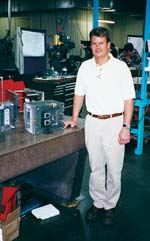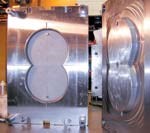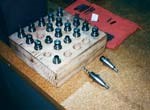The Efficiency Effect
Using machining centers that might otherwise mill electrodes, this Minnesota mold shop does its cutting directly in steel. The streamlined process has exceeded expectations and yielded a striking increase in sales.
Share




The year 1997 seems like only yesterday, but to Tim Holland, vice president of Metro Mold & Design Inc. (MMD), Rogers, Minnesota, it represented the end of another stage in the company's ongoing development plan. That was the year when he attended a local tooling show and observed a demonstration of high speed machining. Mr. Holland was convinced by this experience that MMD's hard milling and electrode milling processes could be substantially improved by upgrading equipment (Figure 1, below right).
Today, MMD is reaping the benefits of this strategic decision. When sales figures were examined for 1998—the first full year after the company installed its initial high speed machine—Mr. Holland did a double-take. His numbers showed a 63-percent sales growth with only a 12-percent increase in MMD's workforce. From 1999 to the present, the good news has continued. Since it began using the new equipment, the company has realized overall sales growth of 176 percent while increasing employment only 41 percent.
MMD's quantum leap in performance is based on very competitive unit costs and greater production capacity. "High speed machining has played a huge part in our overall sales increase, and it's all due to greater efficiencies, as well as the efforts of our employees," says Mr. Holland. This technology enables the company to be more successful in an increasingly competitive marketplace. It also allows the company to increase sales by adding additional production capacity.
While many moldmakers have expressed concerns about overseas competition, Mr. Holland is equally concerned about domestic competition. In efforts to utilize idle capacity, some competitors may accept lower-than-normal profit margins—and some recently established shops seeking to attract new clients may cut prices initially. Facing these competitive pressures, MMD's ability to reduce its production costs at the same time it improves capacity is an invaluable advantage.
Even when price isn't the overriding concern, a process that allows a mold shop to substantially reduce delivery time can be a priceless advantage. "It's difficult to put a value on losing a customer because you can't meet their delivery schedule," says Mr. Holland.
MMD specializes in building high production and pre-production injection molds that typically incorporate a maximum of eight cavities. The company was founded in 1972 by Tim's parents, John and Carol Holland, and John is the President/CEO. Tim joined MMD after graduating from a local technical college in 1989. During this initial period, he gained valuable experience in the metalworking trade and became shop foreman in 1992. At that time, the company employed only 14 people.
From the outset, thermoplastic injection molds have represented the majority of the company's products. Today, injection molds comprise 80 percent of the work performed by MMD's 52 employees. Approximately 15 percent of the company's work consists of thermal-set molds. MMD produces molds for everything from soft-drink dispensers to storage containers for semiconductors (Figures 2 and 3, at left and below right). The shop's largest clients include automotive, medical, telecommunications and consumer-electronics firms.
MMD can guarantee machined tolerances as close as 0.0002 inch—a level of precision that has enabled the shop to distinguish itself as a leading producer of tooling for the fuel cell industry. The company also handles a substantial amount of contract machining, specializing in short runs of high precision components.
Because many customers change their part specifications frequently, MMD is accustomed to providing clients with complete design and mold systems that enable them to make engineering changes without experiencing delays in delivery of tooling. Given these requirements, developing high speed capability proved to be a natural fit.
Streamlining The Process
Before it turned up the speed by ultimately purchasing six Roku-Roku high speed machining centers (distributed by Vard-Smith Associates Inc., Midland Park, New Jersey), MMD's production process involved many additional steps. The majority of those extra steps involved various aspects of the EDM process, including programming and cutting electrodes, performing ram EDM work and polishing surfaces to fit the molds' parting lines. While EDM remains an essential operation for machining sharp corners and other features that incorporate high depth-to-diameter ratios, faster cutting speeds now enable MMD to substitute hard milling for many former die-sinking operations.
"As a rule of thumb, a cutting depth of eight times the tool's diameter is the limit," says Mr. Holland. "We have hard milled as deep as 11 times the tool's diameter, but that was done under ideal conditions." Where hard milling is a feasible alternative to EDM, the company eliminates a substantial amount of additional work.
A key advantage of high speed milling is its ability to produce surfaces smooth enough to minimize or eliminate bench work. Using conventional CNC machines, bench time typically represents 25 percent or more of the total time necessary to manufacture a mold. This is the principal time factor addressed by a high speed process. For example, MMD was recently able to hard mill the parting line on a four-cavity mold to a level of smoothness that required no additional finishing.
Although programming time is approximately the same whether cutting steel or milling graphite, the high speed process has caused MMD to dedicate a larger portion of its overall programming work to hard milling. With its current capabilities, MMD raises the question of whether to cut or burn metal more frequently in its production planning.
At the same time that they have replaced certain types of EDM work, the new machining centers have actually created a higher net demand for EDM electrodes (Figure 4, below left) by increasing the company's overall production capacity. To handle this demand, MMD currently uses four Makino (Mason, Ohio) Edge 2 ram EDM machines, one of which is equipped with a pallet changer.
Because high speed machines dramatically increase production and quality of EDM electrodes—as well as mold components—they are well-suited to the needs of a busy company. "Even if we didn't cut hard tool steels and only used our new equipment to mill electrodes, these machines are at least 10 times faster than our older, conventional machines," says Mr. Holland.
But how do high speed machining centers compare to conventional machines in terms of overall performance? According to Mr. Holland, the productive advantage is significant. "Our experience has been that, in terms of capacity, one high speed machine is equivalent to four conventional machines," he says. MMD now uses its conventional vertical machining centers to rough out mold components prior to heat treatment and hardening. But all hard milling and electrode milling work is performed on the high speed machines. Since these high speed machines have been in place, MMD has nearly eliminated form grinding work.
In Mr. Holland's experience, the time savings accompanying a high speed process are substantial. "I calculate that we can complete all hard milling of a four-cavity mold in 8 days, instead of cutting electrodes for 8 days, then adding 8 to 10 additional days for the ram EDM work," he says. "For a 9-week job that normally requires 63 days, we might save 10 days in building the mold. It's easy to see the payoff for both our customers and MMD."
High Speed Tools
To achieve surfaces smooth enough to avoid hand finishing, precision cutting tools and toolholders are essential (Figure 5, below right). Due to the nature of the company's work, bull-nose end mills are used for 90 percent of the high speed cutting. "If sharp corners are required, we pick out the 0.03-inch radius with a flat end mill," he says.
The smallest cutting tools that MMD uses are 0.006-inch diameter ball end mills that are used only to mill graphite, ceramics and other exotic materials. For most of MMD's high speed machines, 6-mm diameter cutting tools are the largest size used. For the company's newest and largest Roku-Roku machine (Figure 6, below right), however, tools up to 12-mm diameter may be used. This machine is specifically designed for graphite milling as well as for steel cutting. It incorporates a Fanuc 16iM CNC, a 30-tool capacity and a 30,000-rpm spindle. The spindle is equipped with an HSK-E40 toolholder shank.
The shop's smaller high speed machines incorporate speed ranges from 3,000 to 36,000 rpm, and each is equipped with an 11-tool capacity. The machines accept tools as large as ¼-inch diameter.
At present, MMD is using collet-type toolholders with its high speed machines. The shop had experienced problems with cracking of shrink-fit toolholders when it originally installed its new equipment. Although Mr. Holland admits that collet-type toolholders are not as accurate as the shrink-fit type, he still has some reservations about the durability of shrink-fit holders. Furthermore, he says, "the collet system allows more versatility at lower cost."
Regarding tool performance at high speeds, Mr. Holland says, "The biggest issue concerning cutter breakage is knowing where the greatest amount of stock remains from the previous cut. Most of this stock will be left in corners, and when we move into a corner with a small-sized cutter, that's where most of the breakage occurs."
The Programming Curve
When a company switches from conventional to high speed machining, programming is one of the first hurdles to overcome. Thus, it's common for implementation of a high speed process to be somewhat difficult and time consuming in the early stages. Although MMD went through a 9-month development period before it perfected its high speed process, Mr. Holland believes that, because of more widespread information and experience with this process, the average learning curve may be somewhat shorter now.
Since MMD purchased its first high speed machine, the company has added four of its six programmers. Two principal factors necessitate this expanded programming capacity. First, the complexity of programs required to generate efficient, high speed tool paths is substantially greater than that necessary for conventional machining operations. This is true because cutting tools are making a larger number of machining passes instead of fewer, heavier cuts. Second, by substantially increasing a shop's overall capacity, high speed machines challenge programmers to maintain the pace of production.
These factors translate to the need for generating a significantly larger number of more complex programs. High speed cutting tools require that chip loads be maintained within very strict ranges. For this reason, additional programming is typically required for separate machining cycles that remove residual stock from corners or various surface features prior to finish machining.
Mr. Holland cites training as perhaps the greatest challenge faced when making the jump to a high speed process. "Training in programming requires a lengthy process before the person becomes truly proficient," he says. Another factor is the numerous decisions that programmers must make in their daily work. "A programmer needs to know more than just programming," says Mr. Holland. "The person also needs to know when to hard mill; when to make an electrode and burn; when it is permissible to leave a small radius; and if a corner must be sharp."
This work requires well-rounded programmers with substantial machining experience. Considering the rate at which a high speed process drives production, a company must have enough properly trained programmers to avoid bottlenecks in its work schedule. Because it's not an easy task to hire and train programmers, a company that aims to initiate a high speed process must develop a long-range plan to ensure that the right people will be available when they're needed. In this regard, MMD takes substantial pride in the quality of its people.
MMD's experience demonstrates the dramatic gains that machine shops can realize, first by investing in high speed equipment, and then by learning and perfecting the necessary machining techniques to optimize this equipment. Given the current pace of technological development, it's impossible to escape the conclusion that tomorrow's machine shop will be a faster and more efficient production environment. It will also be a place where the labor content of each product is considerably smaller. That's why, regardless of economic fluctuations, long-term success in the metalworking industry continues to depend on the timely and intelligent application of new technology to improve the machining process.
Related Content
High RPM Spindles: 5 Advantages for 5-axis CNC Machines
Explore five crucial ways equipping 5-axis CNC machines with Air Turbine Spindles® can achieve the speeds necessary to overcome manufacturing challenges.
Read MoreLean Approach to Automated Machine Tending Delivers Quicker Paths to Success
Almost any shop can automate at least some of its production, even in low-volume, high-mix applications. The key to getting started is finding the simplest solutions that fit your requirements. It helps to work with an automation partner that understands your needs.
Read More6 Machine Shop Essentials to Stay Competitive
If you want to streamline production and be competitive in the industry, you will need far more than a standard three-axis CNC mill or two-axis CNC lathe and a few measuring tools.
Read MoreOrthopedic Event Discusses Manufacturing Strategies
At the seminar, representatives from multiple companies discussed strategies for making orthopedic devices accurately and efficiently.
Read MoreRead Next
Building Out a Foundation for Student Machinists
Autodesk and Haas have teamed up to produce an introductory course for students that covers the basics of CAD, CAM and CNC while providing them with a portfolio part.
Read MoreSetting Up the Building Blocks for a Digital Factory
Woodward Inc. spent over a year developing an API to connect machines to its digital factory. Caron Engineering’s MiConnect has cut most of this process while also granting the shop greater access to machine information.
Read MoreRegistration Now Open for the Precision Machining Technology Show (PMTS) 2025
The precision machining industry’s premier event returns to Cleveland, OH, April 1-3.
Read More




































